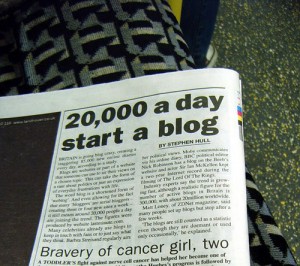The Future of News(papers)
 Craig Henry surveys two pieces from the recent “How to save the dying newspaper industry” meme that’s been going around and sounds a much more optimistic note than generally seen in the blogosphere.
Craig Henry surveys two pieces from the recent “How to save the dying newspaper industry” meme that’s been going around and sounds a much more optimistic note than generally seen in the blogosphere.
He points to a February TIME piece by Walter Isaacson (“How to Save Your Newspaper”) that advocates a micropayment system. While pretty much every blogger who wrote about this idea at the time scoffed at it, Craig observes, “That seems like a pipe dream today, but who knows about tomorrow? Television was once free, but now the average American spends hundreds of dollars each year for his cable or satellite subscription.” That’s a good point, actually.
But what pay television offered that the free version didn’t was variety. In the old days, most of us had the three networks (ABC, NBC, and CBS), plus PBS and a couple of local independents to choose from. Adding just ESPN and CNN was a huge advance and the availability of movie channels like HBO and Showtime was just remarkable. I’m not sure what the online news equivalent of this would be.
The second suggestion, via Mark Potts (“Editors as Curators: What’s Taking So Long?) is that editors could repackage their skills and rethink online newspapers as smart aggregators.
[N]ewspaper and TV sites still generally are trapped in their walled gardens, putting together their daily reports only from the sources they pay for: their own reporters, maybe some wire and syndicated copy and photos, and that’s about it.
On the Web, you’re not limited only to the content you own. You can create a rich, deep package for your readers on any subject by linking to outside sources—background, context, documents, data, video, discussions, blogs, user-generated content, etc. Even, shudder, good stuff from competitors. But with very few exceptions, this is done only tentatively, if at all, at the vast majority of news sites.
Craig calls this “a really smart idea/model” and wonders, “Can the culture of the newsroom support it? Or does a version of the Not Invented (Created) Here syndrome work against it?”
I’d argue, though, that bloggers are pretty much doing this already and for free. It’s Glenn Reynolds‘ bread and butter, of course, but even bloggers that aren’t primarily linkers tend to serve as aggregators. Matt Yglesias, Andrew Sullivan, and other general interest bloggers provide links to dozens of stories of interest to their readers a day and niche blogs like Small Wars Journal are, in additional to a source of original commentary and analysis, smart aggregators of the most important articles and discussions on their topics taking place elsewhere.
So, yes, this is a good model for attracting eyeballs on the Web. But, since thousands of people are doing it for free — and hundreds are doing it well — I’m not sure how that translates into an effective business model for saving newspapers.
Photo by Flickr user Annie Mole under Creative Commons license.






Several aggregator/bloggers have mentioned that they still rely on hard news feeds, so I don’t see bloggers replacing the quantity, quality, broadness or depth that news agencies can deliver at their best.
The problem is, these news agencies haven’t been consistently delivering their best for a long time, and too many observant news junkie have noticed, as for the “lay” reader, they’ve moved to other forms of media.
The problem facing newspapers is being misrepresented. The greatest problem is the consolidation into nationalization and the consequent homogenization. Wire services may make gathering news more efficient but that’s not the sort of efficiency that will save newspapers.
The real problem that newspapers felt is that over the period of the last thirty years so many have been acquired in leveraged buyouts and the resultant company saddled with the debt. That was fine during the days of easy credit but it’s not great now.
There’s space for real print newspapers reporting real news gathered by real newspaper men and women. There isn’t any space for nationwide newspaper chains that pay six and seven figure salaries to publishers and star columnists.
There’s also no space for daily journals of opinion. If you want that on more than a weekly or monthly basis you can read blogs for free.
Well, it’s true there a number of people doing it out there for free. I suppose you can find people in bars every night that will do ‘it’ for free as well. Ultimately, that’s not going to stop the world’s oldest profession from making a profit.
That said, there are a number of people out there who are making a fair amount of money at this blogging game. I will presume to say you’re one of them, James, and so am I. So, one can understand why traditional media outlets would consider that a possibility for their own survival. THere’s obviously money out there to be made, and they think they can do it better.
What they are not considering, is that the newer media types are doing the job that much better, in terms of content, which is why they’re doing well in the dinosaurs are not.
The dinosaurs, for their part, are still stuck in the mold of the medium being a problem, rather than the message. The fact is, until such time as they learn that’s not the cause of their problems, they’re going to continue to sink in whatever medium they may decide to attempt.
Taking a step further, there are a number of people out there who are in fact making money at it because they’re doing it better than the dinosaurs, but who are not making nearly enough money to support a dinosaur type operation. On that basis the dinosaurs have two strikes against them. The first one being because the issue is not the medium but the message, and even if they did it right as many bloggers are, they’re not going to make enough money to save themselves, anyway.
“But what pay television offered that the free version didn’t was variety. In the old days, most of us had the three networks (ABC, NBC, and CBS), plus PBS and a couple of local independents to choose from. Adding just ESPN and CNN was a huge advance and the availability of movie channels like HBO and Showtime was just remarkable. I’m not sure what the online news equivalent of this would be.”
Don’t forget the other major advantage that cable offered, James: quality. Does anybody else remember the days of adjusting TV antennas the entire duration of a show and still getting a result that was barely watchable?
I have a lot of channels that come in over my cable with significantly less quality than I’d prefer. Yet every single one of them is still preferable to the over-the-air reception we used to get in the stone age days before my dad finally caved and got cable.
Your variety point is a good one, and you’re right that there’s no real online equivalent at the moment. There’s also no real equivalent to the quality difference – especially since it wasn’t a quality of content difference but merely a quality of distribution difference. On the internet, distribution quality is pretty much good enough across the board.